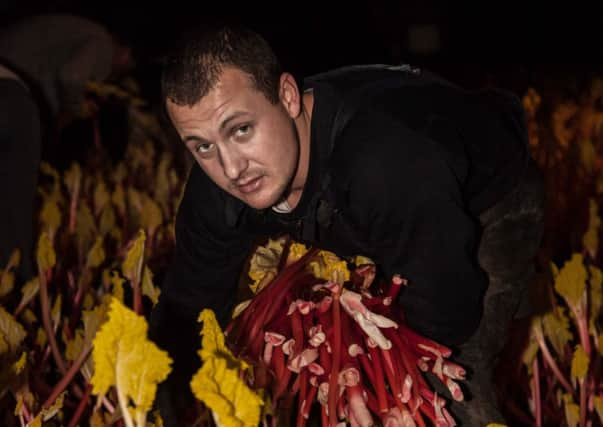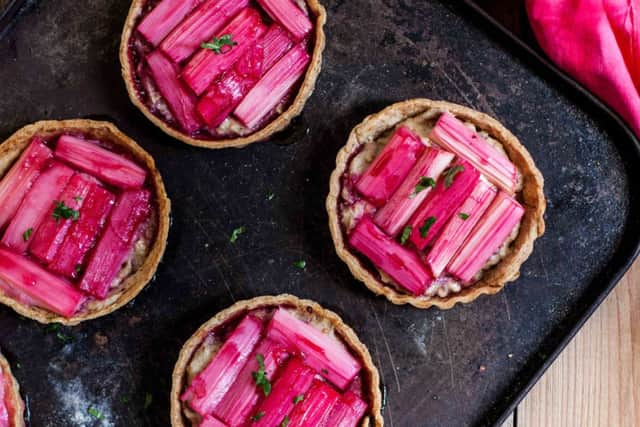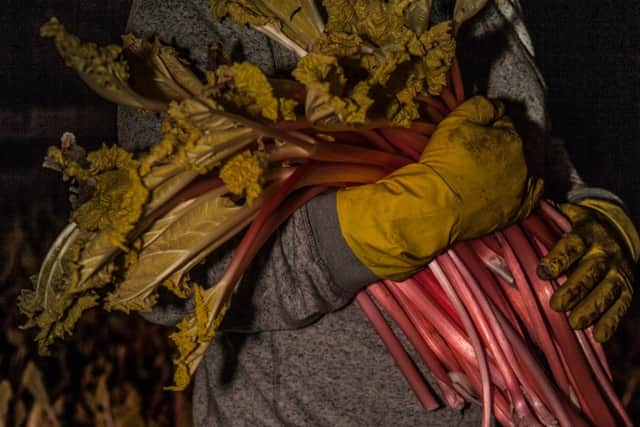Deep inside Yorkshire’s rhubarb triangle


It’s 6am and the temperature is below freezing as I approach Oldroyd’s Farm in Carlton. The moon hangs in the dark sky and every surface is sparkling with minute frost crystals.
I have arrived before dawn to see the famous, forced, fuchsia pink rhubarb being picked in darkened sheds. Carlton is a village near Wakefield which, with Leeds and Bradford forms the Rhubarb Triangle. The Rhubarb Triangle is the heart of the British rhubarb industry.
Advertisement
Hide AdAdvertisement
Hide AdI am met by Neil Hulme, husband of Janet Hulme-Oldroyd, whose great-grandfather began the family business during the depression of the 1930s. Neil takes me into the darkened sheds to view the incredible sight of the pink rhubarb stalks or, more correctly, ‘petiotes’, standing in beautiful rows topped with plumes of frilly, pale yellow leaves.


Neil tells me: “Rhubarb is native to Siberia. The climate in Yorkshire is similar and provides the perfect conditions for rhubarb with plenty of rain, cold weather and nitrogen rich soil. Forced rhubarb begins life as cuttings taken from a mature crown two years before harvesting. When strong enough the cuttings are planted in fields to mature, ready for the forcing sheds.”
By 6.30am the darkened shed where we are standing is full of bodies bent low to the ground carefully and rhythmically picking pink forced rhubarb. Rhubarb is harvested by hand, a time-consuming process as each stem must be removed intact from the root.
“Some of the workers have picked for us for years,” Neil says, “but this year many of the pickers are from Bulgaria.” This has been made possible since restrictions were lifted across the European Union in January.
Advertisement
Hide AdAdvertisement
Hide AdThe pickers gather armfuls of rhubarb, cradling the beautiful magenta stalks as carefully as they would a baby before placing in boxes ready for grading and packing. Oldroyd’s, which is only one of 12 remaining growers in Yorkshire, produces 1,000 tons of rhubarb annually.


Yorkshire rhubarb is sold to supermarkets and restaurants across the UK where British chefs have fallen in love with it all over again. Its colour is spectacular and looks wonderful in a sweet crumble or as a sauce with roast pork. It is a rare local crop in the drab winter months.
It is cold in the sheds and Neil and I are blasted with a jet of heat from propane-fuelled blowers which make the rhubarb bend in the warm breeze. In the past the sheds were heated by stoves fuelled by coal supplied from the nearby collieries.
So what is so special about Yorkshire’s pink rhubarb? Forced rhubarb has a sherbet, tangy flavour and a delicate texture. It is a far cry from the tannic-flavoured overgrown outdoor stems used in harshly flavoured school pies and crumbles.
Advertisement
Hide AdAdvertisement
Hide AdJanet Hulme-Oldroyd, who worked as a scientist at St James’s Hospital, Leeds, before joining her late father Kenneth Oldroyd in the family business, explained how the process of ‘forcing’ rhubarb creates the highly prized crop.
“The rhubarb crowns are lifted from the fields in December after they have received the correct number of ‘frost units’. Exposure to frost makes the rhubarb crown break its winter dormancy and stimulate the conversion of starch stored in the rhubarb crown to glucose. This provides energy for the rhubarb to grow quickly without light.
“Light discolours and toughens rhubarb and for this reason rhubarb used to be harvested by candlelight. These days’ low electric lights are mostly used.”
Rhubarb needs lots of nitrogen to grow well and traditionally the fields were fertilised with shoddy, a byproduct of the wool industry. Spreading shoddy reduces the need for synthetic fertilisers as microbes in the soil break down the wool fibres to produce nitrogen. Local textiles companies such as Hainsworth’s in Pudsey have been supplying the Rhubarb Triangle with wool waste for generations.
Advertisement
Hide AdAdvertisement
Hide AdJanet says: “Rhubarb used to be eaten extensively in the UK before the Second World War. It then fell from favour as other fruit was imported from Europe and further afield after rationing ceased in the early 1950s. My favourite way of eating rhubarb is simply stewed and stirred into yogurt.”
Odd as it may seem rhubarb is a vegetable. The plant was originated cultivated for its medicinal qualities including its use as a laxative. Today research is investigating the anti-cancer properties of several active compounds in rhubarb known as anthraquinones. It took until the 18th century before rhubarb was grown for culinary purposes in Britain.
The EU has now recognised Yorkshire rhubarb as a regional product, like Champagne in western France, and has given it Protected Designation of Origin status from the European Commission’s Protected Food Name scheme. There are more than 40 British products on the list. The list also includes Grimsby smoked fish and Swaledale cheese.
Before I leave, Janet gives me a final pearl of wisdom: “Dutch forced rhubarb is also available in the shops at the moment but there is a difference. Dutch rhubarb is grown in a warmer climate and is not subjected to sub-zero temperatures. The flavour and texture is therefore different. So buy Yorkshire rhubarb if you can.”
Advertisement
Hide AdAdvertisement
Hide AdWakefield Festival of Food Drink and Rhubarb takes place this year between February 21 and 23. www.experiencewakefield.co.uk
To book a tour of the Oldroyd’s rhubarb forcing sheds www.yorkshirerhubarb.co.uk